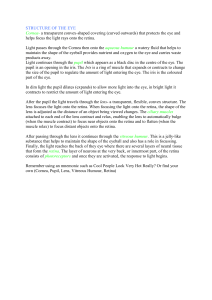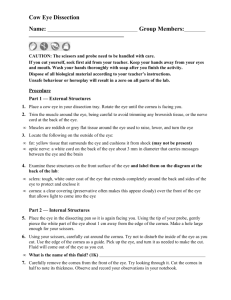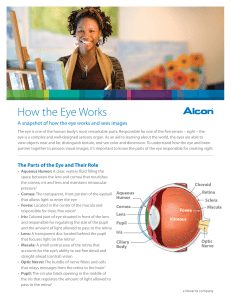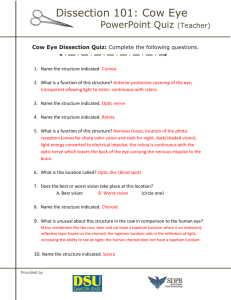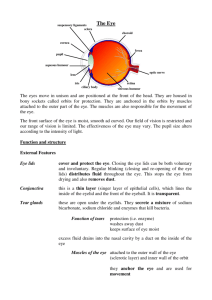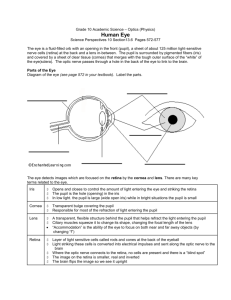CowEyeDissectionStudentChecklist
advertisement
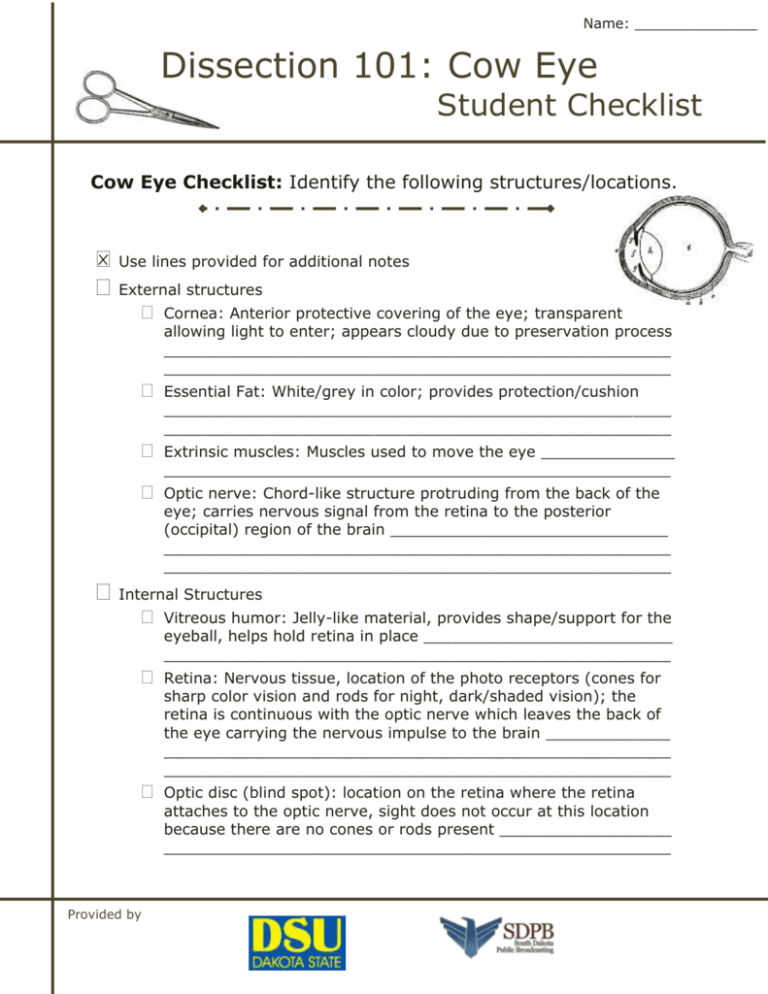
Name: ______________ Dissection 101: Cow Eye Student Checklist Cow Eye Checklist: Identify the following structures/locations. Use lines provided for additional notes External structures Cornea: Anterior protective covering of the eye; transparent allowing light to enter; appears cloudy due to preservation process _____________________________________________________ _____________________________________________________ Essential Fat: White/grey in color; provides protection/cushion _____________________________________________________ _____________________________________________________ Extrinsic muscles: Muscles used to move the eye ______________ _____________________________________________________ Optic nerve: Chord-like structure protruding from the back of the eye; carries nervous signal from the retina to the posterior (occipital) region of the brain _____________________________ _____________________________________________________ _____________________________________________________ Internal Structures Vitreous humor: Jelly-like material, provides shape/support for the eyeball, helps hold retina in place __________________________ _____________________________________________________ Retina: Nervous tissue, location of the photo receptors (cones for sharp color vision and rods for night, dark/shaded vision); the retina is continuous with the optic nerve which leaves the back of the eye carrying the nervous impulse to the brain _____________ _____________________________________________________ _____________________________________________________ Optic disc (blind spot): location on the retina where the retina attaches to the optic nerve, sight does not occur at this location because there are no cones or rods present __________________ _____________________________________________________ Provided by Dissection 101: Cow Eye Student Checklist Name: ______________ (Continue page 2) Internal Structures Fovea centralis/macula: Location in eye where the sharpest vision occurs; the fovea centralis/macula is dense with cones and is the location of focus during lighted conditions, like reading; the fovea centralis/macula appears as a depression in the retina (Note: know the function for the quiz, identification is not required ) ____________________________________________ _____________________________________________________ _____________________________________________________ Choroid: Dark layer of the eye, rich with blood vessels; reduces scattering of light and provides nourishment for the eye ________ _____________________________________________________ _____________________________________________________ Tapetum lucidum: Iridescent, reflective layer found on the choroid; the tapetum lucidum aids in the reflection of light, increasing the ability to see at night; the human choroid does not have a tapetum lucidum ______________________________________________ _____________________________________________________ Sclera: Tough protective outer layer of the eye which gives the eyeball it’s shape; the white part of the human eye; continuous with the transparent cornea; the sclera has blood vessels (may appear bloodshot); the cornea does not have blood vessels ______ _____________________________________________________ _____________________________________________________ Suspensory ligaments: Hold the lens in place, attaches lens to ciliary body ____________________________________________ _____________________________________________________ Aqueous humor, a transparent fluid produced by the ciliary body is located between the lens and the cornea; the fluid provides shape for and nourishes the cornea and it also provides nourishment for the lens ______________________________________________ _____________________________________________________ Lens: Biconvex structure that focuses light on the retina through a process called accommodation ____________________________ _____________________________________________________ Provided by Dissection 101: Clam Name: ______________ Student Checklist Ciliary body: Muscles of the ciliary body contract toward the lens, resulting in less pull on the lens; the lens bulges to its natural form resulting in the light rays bending more for closer objects; the muscles of the ciliary body relax pulling away from the lens causing the lens to flatten for distant objects _________________ _____________________________________________________ Pupil: Opening of the eye, allows light to enter; the diameter of the opening is controlled by the iris; the pupil is the dark center of the eye; the pupil is black because light enters but it does not leave. _____________________________________________________ _____________________________________________________ Iris: Structure of the eye which controls the size of the opening into the eye which is called the pupil; the pupil gets larger when the radial muscles of the iris contract in dim light; the circular/sphincter muscles of the iris contract to reduce the size of the pupil for brighter light; the iris is the colored structure of the human eye ____________________________________________ _____________________________________________________ Draw and label the cow eye. Cornea Retina Tapetum lucidum Suspensory ligaments Pupil Provided by (Continue page 3) Optic nerve Optic disc (blind spot) Sclera Lens Iris Vitreous humor Choroid Aqueous humor Ciliary body Images courtesy FCIT, http://etc.usf.edu/clipart



